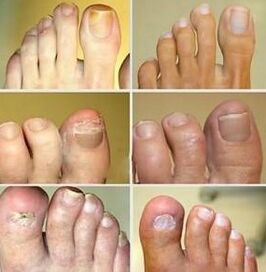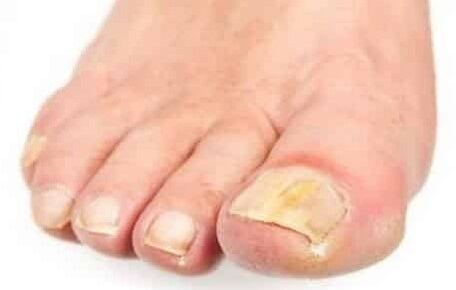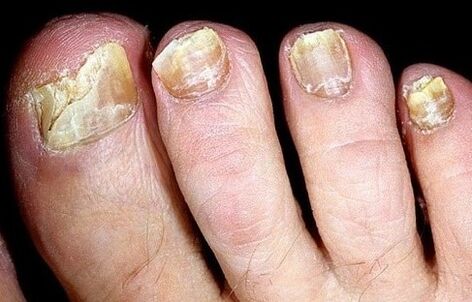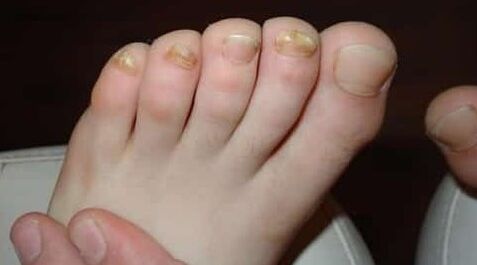Ocomecojcosis is a pathology that destroys nail plates.Mushroom eats Keratin - a building base.The infection falls into intercellular space and starts its division.In advanced phases, pathology can affect the skin of the foot, intermediate zone, Pete.

Causes of nail fungus
Infected by onnicmicosis is quite simple.The infection can be loved on the beach, in a public soul, a pool.High probability of capturing fungus from infected relatives or acquaintances (using common lives).
There are several main prerequisites that can provoke virus entry into the human body:
- Weak immune system - reduction of protective forces due to infectious or inflammatory diseases;
- vascular pathology (vein block) Breach of interior bodies (diabetes), leading to problems with blood circulation in lower extremities;
- less skin damage on their feet (scratches, microcracks, corn, corn) resulting in as a result of wearing narrow shoes;
- ignoring the rash of diapers and intense sweating of lower extremities;
- Violation of precautions - Attempted someone else's shoe, visiting public places without slippers and neglecting leg hygiene.
Types of nail fungus
OnyhyComyCosis can cause several types of fungi.Dermatophytes, for example, appear in the form of nail blur.There is a formation of yellow spots along the edges or in the middle of the plate.In addition, longitudinal stripes along the affected area can be observed.
The yeast mushroom causes the deformation of the nail plate.It is very sophisticated and begins to hit their place, it becomes grayish.The metabolism in injured cells is worsening, the furrows appear on the nail roller.In addition, inflammation, edema, redness appears on the neighboring epidermis, the disappearance of the nail skin is observed.
The bacteria molds can injure the nail plate if there are already diseases that cause nail nutrition disorders.In this case, there is also a blur of plates, changes in color (from the bright yellow and greenish to brown and even).
To learn the cause and pathogen of negative changes in the skin and nails, you must contact the expert.An independent determination of diseases and its treatment without consulting the doctor can be left to the consequences.
Stages of the disease

Mycosis nails gradually affects healthy cells.The disease has several phases of development, each of which has its own special events.
The first phase ofychomicosis (normotorophytic) has no bright events.In most cases, access is concealed.The first signs - the nail slightly fades, its color changes, microcracks and yellow spots form in the shape of circles or longinuds, and the toubers appear.Notice fungus can be accompanied by itching and burning.It is difficult to identify the infection in the initial phase as the symptoms are similar to other diseases (psoriasis, liver pathology).
If treatment does not start on time, the disease will go to the next phase - hypertrophic.The nail is thickening, dark.There is a deformation of the plate, crowning and destruction.
The advanced form of nail disease is manifested by a strong stering nail slab, which leads to further rejection.The adjacent skin becomes blue, an unpleasant odor appears.
Symptoms
OnihyComyCosis most often affects nails on their feet, the hands suffer less often.The disease begins with your thumb and a small finger (the exterior edge is touched), smoothly affects all plates.
Leading symptoms of anointomicosis will help in determining a fungal infection:
- the appearance of tape and blemishes of whitish or greenish shades under nail;
- Blogging of plates, color change (from yellow to dark brown);
- redness and skin peeling around the nail;
- the appearance of roughness on the feet and between the fingers;
- Forming molds on nails.
Types of fungal nail diseases
OnihyComyCosis is usually classified by the appearance of affected areas.Since the classification looks like is what looks fungi on the nails, differs in three species, depending on clinical events:
- Atrophic or onholitnic - in which nail plate is significantly affected, to the degree of rejection from nail bed;
- Hypertrophic appearance, in which he lost his natural glow, changes color (bleaching or, vice versa, dark) and structure (more tangible) with the appearance of different types of deformations, and even destroys along the edges;
- Normotrophic - a species characterized by the lowest degree of damage, in which nails are not thickened, remaining great and smooth, but still turns on the appearance of the point, stripes and other visible changes in its natural transparency and color.

In foreign countries there is another classification according to which mushrooms on nails is divided into species depending on the specific location of the lesion:
- In total, in which the entire nail panel is covered by the pathogenic process;
- distal - a form of damage, localization only on the free edge of the nail protruding above the finger;
- Proximal, in which the edge of the plate appears below the nail roller (opposite the free edge of the nail!);
- The lateral form of damage, which affect the sides of the nail plate.
What does pathology look like
Fungal diseases of nails among the population have external similarities with other dermatological diseases of the ungracious nature.Depending on the phase of pathology, the nails are beginning to look unhealthy because they lose natural glow and transparency.Smooth and even, they become thick and deformed and are covered with various colors (often white or dirty yellow).The soft tissues surrounding the Keratin layer destroyed by parasites are also included in inflammatory reactions, swollen and ulceration.
If we consider the image of the destruction of nail plates in the disease dynamics perspective, then it can be conditionally divided into three consecutive phases:
- In the first phase, there are practically no signs, except for lightweight municipality, points or stripes on a plate.
- At such a - phase-made phase, replacing the initial, all symptoms of onnicomicosis become obvious.
- Advanced phase is the ultimate degeneration of the nail, can be supplemented by the appearance of the unpleasant odor of the tissue decay.
Reasons for the deformation of the nail
Mold, fungus such as yeast and dermatophytic fungus cause infectious nail diseases (onnikmicism), manifest similar symptoms.All types of nail fungus on their feet or arms deform nail plate, change its transparency, shine, color.Changes of the nail were found not only with onynchomicoses, but also for injuries, chronic parrichia (inflammation of nail rollers), psoriasis, manual eczema, dermatitis.Before pulling the conclusion about a fungal infection, you need to consider all possible options.
Symptoms of fungi
There are different classifications of nail fungus, depending on the type and event, they can have completely different signs and symptoms, so it is very important to determine (psoriasis, eczema, wanderer and dermatophyte).The surface onnicmicomiza on his fingers is manifested almost after infection, consider symptoms and signs of fungus on legs and arm nails:
- Thickened plate;
- Brittle, crumbs or torn nails not only near the edge, but also throughout the surface;
- Distorted forms, scaly structure;
- The initial phase is a loss of gloss and elasticity;
- If the nail is cursed (not at cost when a person is working regularly with colored compositions or mechanical parts);
- Nails collapses under the skin;
- Disbacteriosis begins, perhaps a general decline in immunity, strength, drowsiness;
- Itching between the fingers and on foot is especially pronounced in the child;
- Testing out of nail beds is a very common phenomenon and almost the last phase before the full loss of the nail, which is called onycholisis.You can feel your fingers pain and find something unpleasant smell;
- The skin becomes dry, cracks, a rash appears, even the appearance of blood or souna;
- Mold white or yellow circle under the nail, depending on the diversity of the fungus, can be bright, dull, with plunner of the edges and mud structure.

Before starting active actions, it is necessary to minimize the negative impact of the external environment, to eliminateThe reasons why fungus appearedUnder nails on their feet:
- The warm and humid environment is ideal for the growth of different microorganisms, try to dry the shoes after walking, wear socks only from natural materials that provide normal heat and air exchanges;
- Fungus feet often appears due to bad immunity, you can only step on the floor with your bare foot and pick up infection, take vitamins to avoid it;
- Frequent nail continuing can become one of the causes of onnicmicosis, limit the procedure up to 1 session in six months;
- The most complicated is nice - this is a fungus caused by active disputes.She penetrates the indentation of the nail and fingers, can be in the sleep stage for a while, then grow sharply.They are most often infected in public use (swimming pools, showers, solarium), during the operation of other shoes, etc.
Shared species of mycosis stops
There are many ways to get the infection to get leg muzzles, but it is possible only by direct contact with pathogen.Most often this happens during the use of other people's shoes or violating personal hygiene rules.Leather mushrooms on their legs usually manifest through destruction of dermis, which is reflected in the form of peeling.The epidermis lesions in this case are caused by the fact that the infection penetrates into deep skin layers, destroying its structure.
Modern medicine identifies the following options for fungal harm to legs, each differs in their symptoms and treatment options:
- Intodallic micosa is the most common form in the form that is manifested.The symptom is usually localized between 3 and 4 fingers, less often between 4 and 5, looks like a crack covered with white film.It is possible to exhibit a certain amount of fluid, border peeling, as well as the appearance of signs of diaper rash.The signs of interdigital fusses can be accompanied by a low itchy.Such a fungus on the fingers of his legs can initially appear completely without symptoms, but in the future there is a significant change in the structure of the skin.
- The mushrooms with a squam hypercheralatotic may differ from other types of heavy scrub and keratinization that affect the epidermis.It is characteristic of people suffering from different types of dermatitis, mostly atopic.This is another type of illness that can be clearly seen which fungus are on their feet.The main symptom of the disease is the appearance of the erythema, a painful pink kunder, in the affected area that has clear borders.Follow up with weak subsidies, cracks on feet, dryness, pain, yellow and nail damage.Onihomikosa, usually accompanying this type of fungus, leads to nail stratification;
- Mushroom vessel is one of the most urgent types of infection, which affects the skin of the leg.Ailment was named to form Vesicula - Bubbles with liquid content, in which erosion is formed, which is dangerous for infection.Main signs that fungal wining differs: the appearance of blisters with a diameter of up to 1 centimeters, as well as a weak itch;
- Deleted fungus.In the initial phase there is a slight peeling on the legs of the legs, as well as the appearance of small cracks, from the outside that affect only the top layer of the epidermo.
- The fungus is discheder, which is an infection in medical practice only in 8% of patients infected with Mikosa.It is localized mainly on the solution and vault of foot, manifestes in the form of bubbles, are gradually merged into one, after which its gap is followed by forming extensive erosion.The danger of fungi of this type is the possibility of connecting bacterial infection, because pathogenic microorganisms are easily penetrating through the resulting wound;
- Internal micoscope is generated not only independently, but also as an accompaniment of the squamous shape of the legs of the leg.It is manifested between the fingers of the feet, characterized by a difficult itching and ignition, a diaper rash and the appearance of erosion;
- Thosehomicosis is another common damage option, which is a nail fungus on your feet.It usually develops from the free edge of nail plate, the initial phase characterizes the look of yellow points, after which the disease is progressing with relaxation and complete leaving the nail.Often accompanies other forms of fungal lesions;
- A candidal fungus, which is called the erosion of yeast, which is localized in the intermediate area.In this case, the fungus on the legs appears as a concentration of lit swollen areas, which can surround a small shape pustula.

















